Marketing Strategy and Plan: Nestle's Global Expansion Analysis
VerifiedAdded on 2021/05/31
|13
|3604
|220
Report
AI Summary
This report provides a comprehensive analysis of Nestle's marketing strategy and plan, focusing on its global expansion. It begins with an introduction to Nestle and its product offerings, specifically chocolate and confectionery. The report then delves into situational analysis, including PESTLE and SWOT analyses, to assess the external and internal environments. Competitive analysis is conducted, highlighting key competitors like Unilever and Danone, and comparing their marketing mixes. The report examines consumer buyer characteristics and segmentation, targeting, and positioning strategies. Finally, it analyzes Nestle's marketing mix, including product, price, place, and promotion strategies. The report concludes with a summary of findings and recommendations.
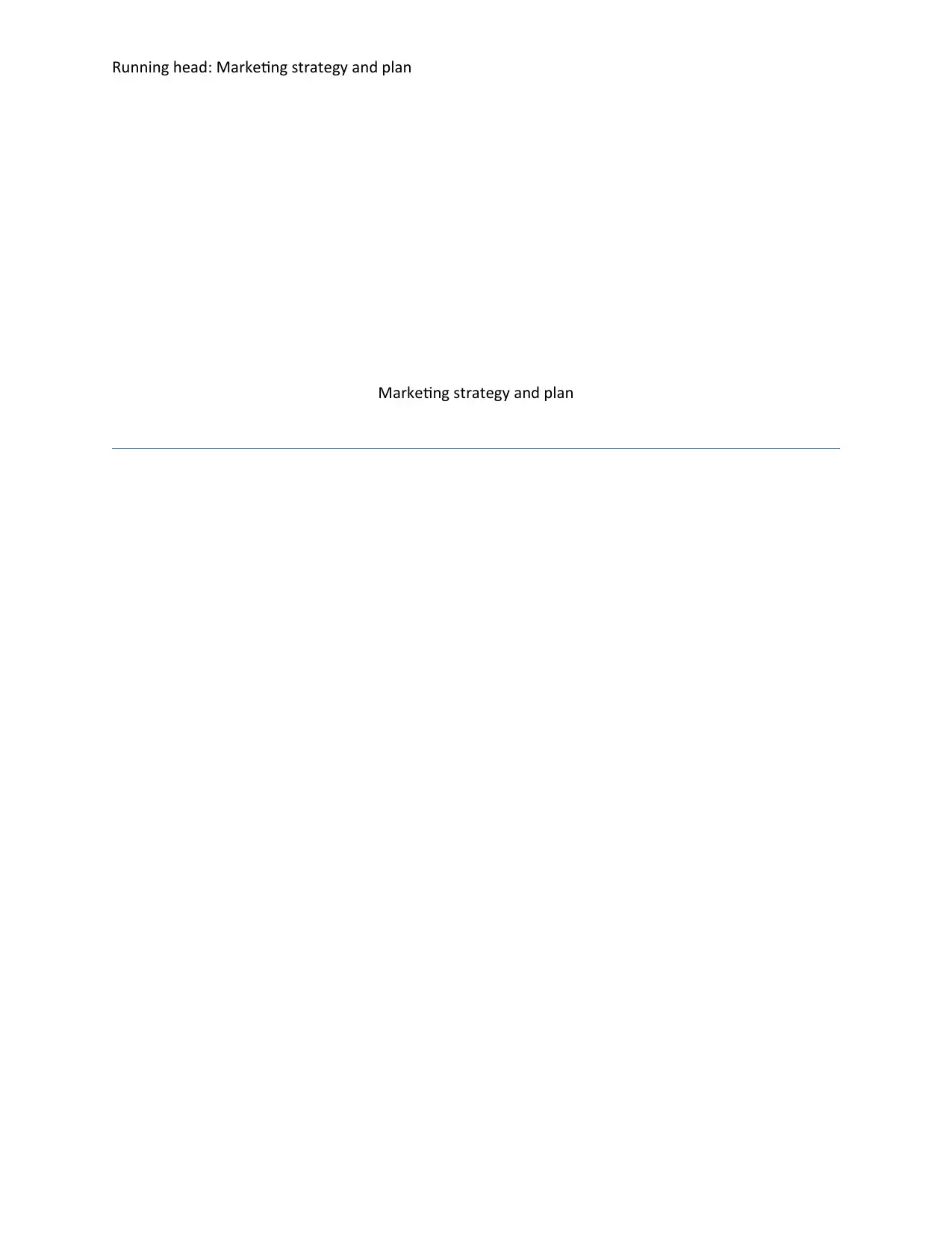
Running head: Marketing strategy and plan
Marketing strategy and plan
Marketing strategy and plan
Paraphrase This Document
Need a fresh take? Get an instant paraphrase of this document with our AI Paraphraser
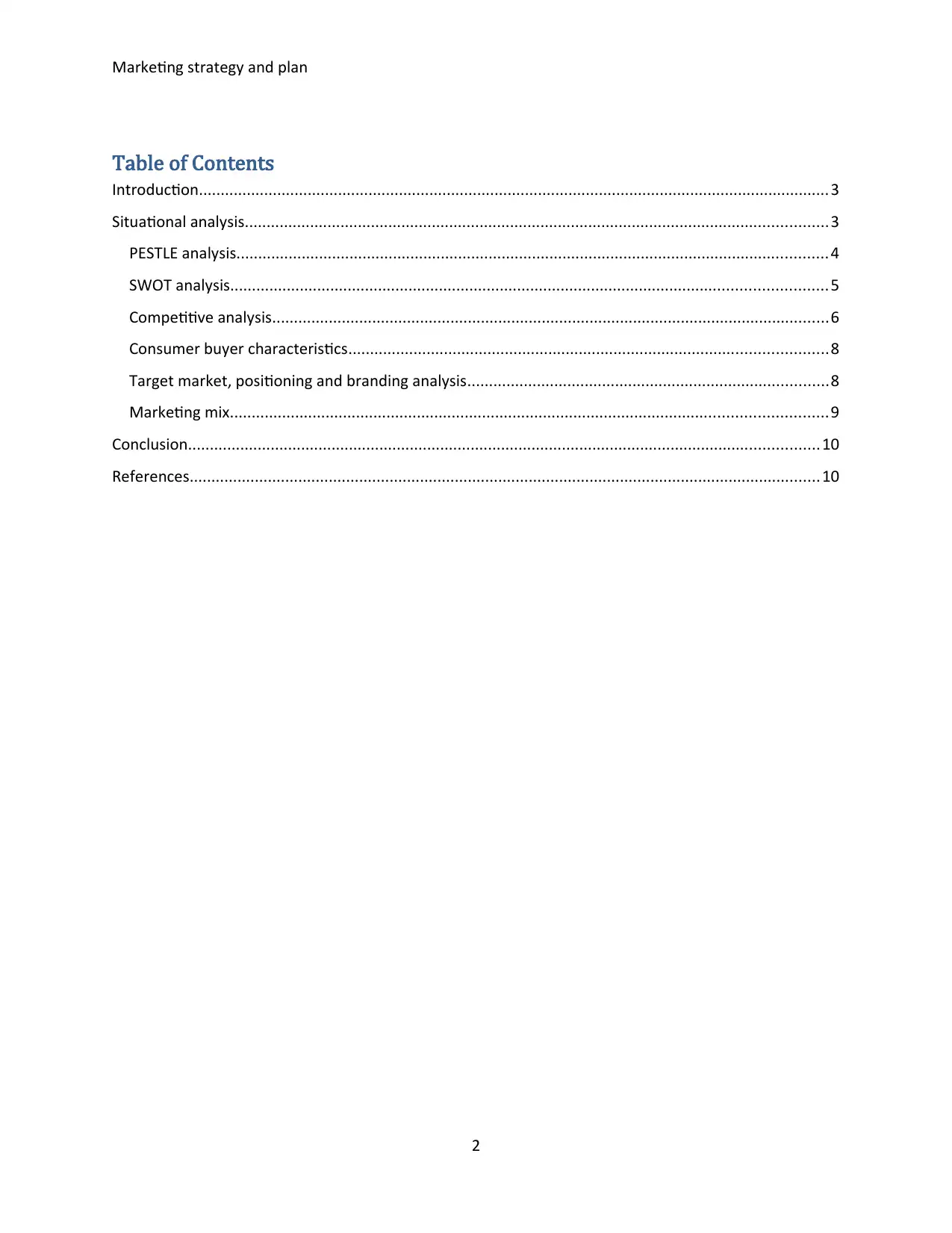
Marketing strategy and plan
Table of Contents
Introduction.................................................................................................................................................3
Situational analysis......................................................................................................................................3
PESTLE analysis........................................................................................................................................4
SWOT analysis.........................................................................................................................................5
Competitive analysis................................................................................................................................6
Consumer buyer characteristics..............................................................................................................8
Target market, positioning and branding analysis...................................................................................8
Marketing mix.........................................................................................................................................9
Conclusion.................................................................................................................................................10
References.................................................................................................................................................10
2
Table of Contents
Introduction.................................................................................................................................................3
Situational analysis......................................................................................................................................3
PESTLE analysis........................................................................................................................................4
SWOT analysis.........................................................................................................................................5
Competitive analysis................................................................................................................................6
Consumer buyer characteristics..............................................................................................................8
Target market, positioning and branding analysis...................................................................................8
Marketing mix.........................................................................................................................................9
Conclusion.................................................................................................................................................10
References.................................................................................................................................................10
2
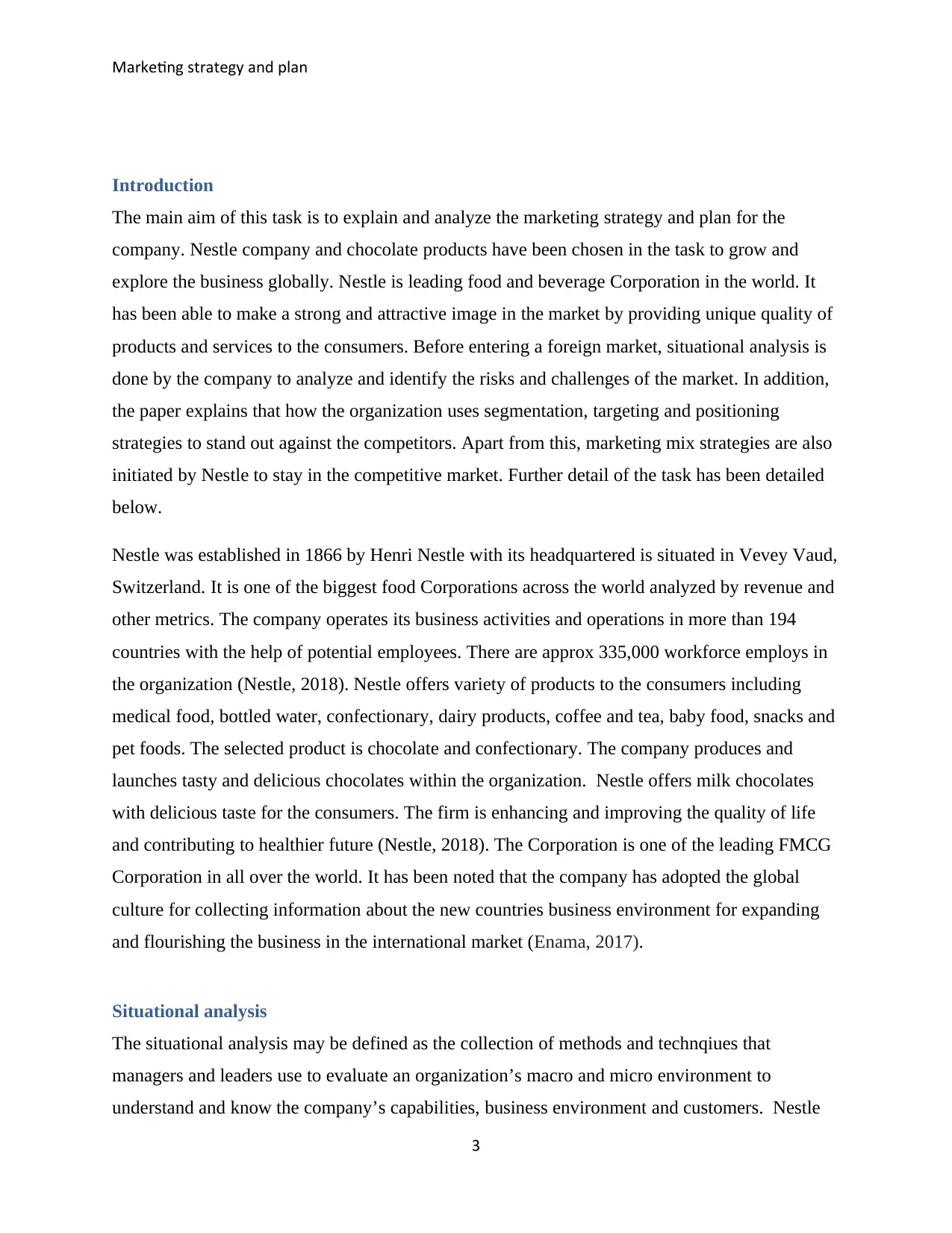
Marketing strategy and plan
Introduction
The main aim of this task is to explain and analyze the marketing strategy and plan for the
company. Nestle company and chocolate products have been chosen in the task to grow and
explore the business globally. Nestle is leading food and beverage Corporation in the world. It
has been able to make a strong and attractive image in the market by providing unique quality of
products and services to the consumers. Before entering a foreign market, situational analysis is
done by the company to analyze and identify the risks and challenges of the market. In addition,
the paper explains that how the organization uses segmentation, targeting and positioning
strategies to stand out against the competitors. Apart from this, marketing mix strategies are also
initiated by Nestle to stay in the competitive market. Further detail of the task has been detailed
below.
Nestle was established in 1866 by Henri Nestle with its headquartered is situated in Vevey Vaud,
Switzerland. It is one of the biggest food Corporations across the world analyzed by revenue and
other metrics. The company operates its business activities and operations in more than 194
countries with the help of potential employees. There are approx 335,000 workforce employs in
the organization (Nestle, 2018). Nestle offers variety of products to the consumers including
medical food, bottled water, confectionary, dairy products, coffee and tea, baby food, snacks and
pet foods. The selected product is chocolate and confectionary. The company produces and
launches tasty and delicious chocolates within the organization. Nestle offers milk chocolates
with delicious taste for the consumers. The firm is enhancing and improving the quality of life
and contributing to healthier future (Nestle, 2018). The Corporation is one of the leading FMCG
Corporation in all over the world. It has been noted that the company has adopted the global
culture for collecting information about the new countries business environment for expanding
and flourishing the business in the international market (Enama, 2017).
Situational analysis
The situational analysis may be defined as the collection of methods and technqiues that
managers and leaders use to evaluate an organization’s macro and micro environment to
understand and know the company’s capabilities, business environment and customers. Nestle
3
Introduction
The main aim of this task is to explain and analyze the marketing strategy and plan for the
company. Nestle company and chocolate products have been chosen in the task to grow and
explore the business globally. Nestle is leading food and beverage Corporation in the world. It
has been able to make a strong and attractive image in the market by providing unique quality of
products and services to the consumers. Before entering a foreign market, situational analysis is
done by the company to analyze and identify the risks and challenges of the market. In addition,
the paper explains that how the organization uses segmentation, targeting and positioning
strategies to stand out against the competitors. Apart from this, marketing mix strategies are also
initiated by Nestle to stay in the competitive market. Further detail of the task has been detailed
below.
Nestle was established in 1866 by Henri Nestle with its headquartered is situated in Vevey Vaud,
Switzerland. It is one of the biggest food Corporations across the world analyzed by revenue and
other metrics. The company operates its business activities and operations in more than 194
countries with the help of potential employees. There are approx 335,000 workforce employs in
the organization (Nestle, 2018). Nestle offers variety of products to the consumers including
medical food, bottled water, confectionary, dairy products, coffee and tea, baby food, snacks and
pet foods. The selected product is chocolate and confectionary. The company produces and
launches tasty and delicious chocolates within the organization. Nestle offers milk chocolates
with delicious taste for the consumers. The firm is enhancing and improving the quality of life
and contributing to healthier future (Nestle, 2018). The Corporation is one of the leading FMCG
Corporation in all over the world. It has been noted that the company has adopted the global
culture for collecting information about the new countries business environment for expanding
and flourishing the business in the international market (Enama, 2017).
Situational analysis
The situational analysis may be defined as the collection of methods and technqiues that
managers and leaders use to evaluate an organization’s macro and micro environment to
understand and know the company’s capabilities, business environment and customers. Nestle
3
⊘ This is a preview!⊘
Do you want full access?
Subscribe today to unlock all pages.

Trusted by 1+ million students worldwide
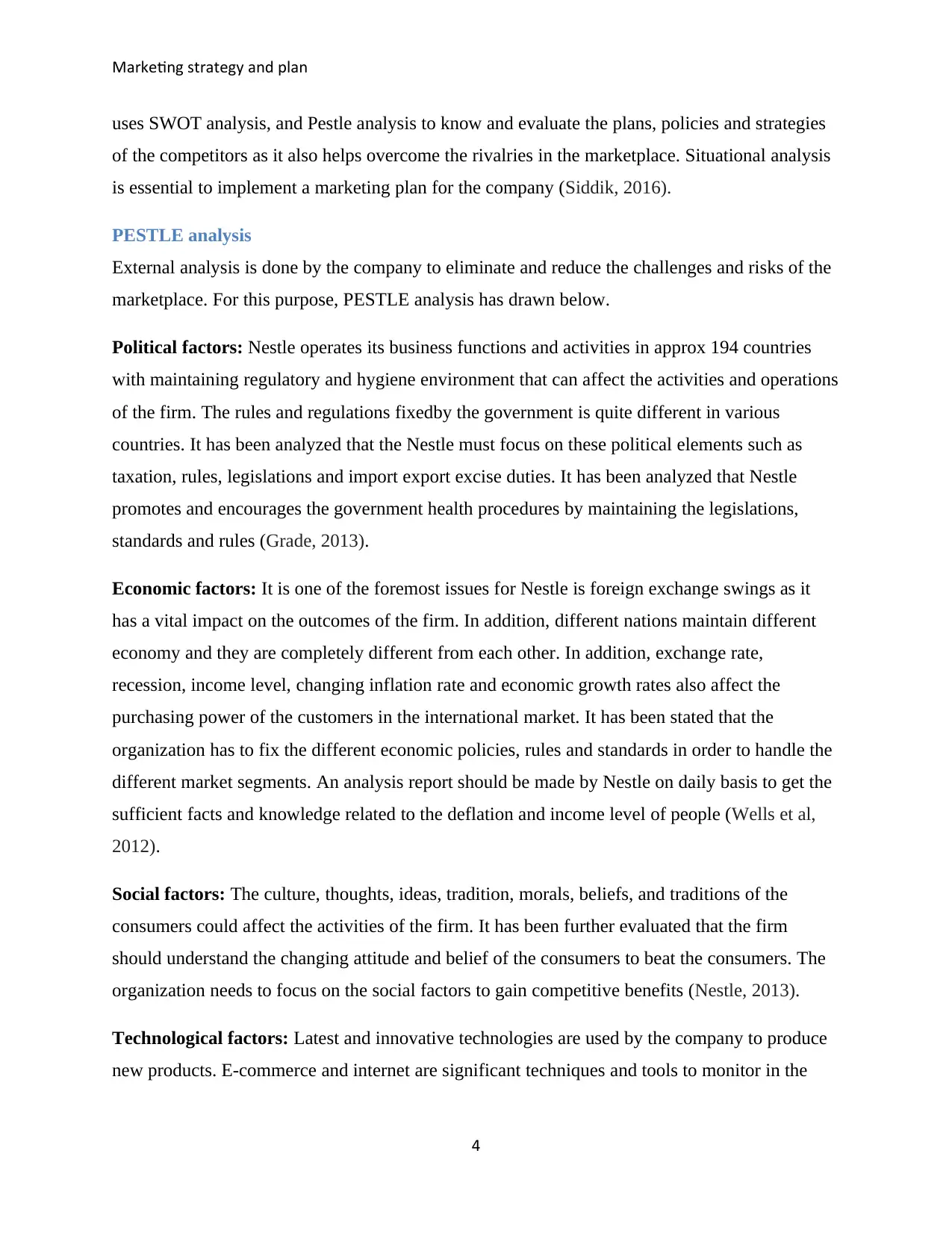
Marketing strategy and plan
uses SWOT analysis, and Pestle analysis to know and evaluate the plans, policies and strategies
of the competitors as it also helps overcome the rivalries in the marketplace. Situational analysis
is essential to implement a marketing plan for the company (Siddik, 2016).
PESTLE analysis
External analysis is done by the company to eliminate and reduce the challenges and risks of the
marketplace. For this purpose, PESTLE analysis has drawn below.
Political factors: Nestle operates its business functions and activities in approx 194 countries
with maintaining regulatory and hygiene environment that can affect the activities and operations
of the firm. The rules and regulations fixedby the government is quite different in various
countries. It has been analyzed that the Nestle must focus on these political elements such as
taxation, rules, legislations and import export excise duties. It has been analyzed that Nestle
promotes and encourages the government health procedures by maintaining the legislations,
standards and rules (Grade, 2013).
Economic factors: It is one of the foremost issues for Nestle is foreign exchange swings as it
has a vital impact on the outcomes of the firm. In addition, different nations maintain different
economy and they are completely different from each other. In addition, exchange rate,
recession, income level, changing inflation rate and economic growth rates also affect the
purchasing power of the customers in the international market. It has been stated that the
organization has to fix the different economic policies, rules and standards in order to handle the
different market segments. An analysis report should be made by Nestle on daily basis to get the
sufficient facts and knowledge related to the deflation and income level of people (Wells et al,
2012).
Social factors: The culture, thoughts, ideas, tradition, morals, beliefs, and traditions of the
consumers could affect the activities of the firm. It has been further evaluated that the firm
should understand the changing attitude and belief of the consumers to beat the consumers. The
organization needs to focus on the social factors to gain competitive benefits (Nestle, 2013).
Technological factors: Latest and innovative technologies are used by the company to produce
new products. E-commerce and internet are significant techniques and tools to monitor in the
4
uses SWOT analysis, and Pestle analysis to know and evaluate the plans, policies and strategies
of the competitors as it also helps overcome the rivalries in the marketplace. Situational analysis
is essential to implement a marketing plan for the company (Siddik, 2016).
PESTLE analysis
External analysis is done by the company to eliminate and reduce the challenges and risks of the
marketplace. For this purpose, PESTLE analysis has drawn below.
Political factors: Nestle operates its business functions and activities in approx 194 countries
with maintaining regulatory and hygiene environment that can affect the activities and operations
of the firm. The rules and regulations fixedby the government is quite different in various
countries. It has been analyzed that the Nestle must focus on these political elements such as
taxation, rules, legislations and import export excise duties. It has been analyzed that Nestle
promotes and encourages the government health procedures by maintaining the legislations,
standards and rules (Grade, 2013).
Economic factors: It is one of the foremost issues for Nestle is foreign exchange swings as it
has a vital impact on the outcomes of the firm. In addition, different nations maintain different
economy and they are completely different from each other. In addition, exchange rate,
recession, income level, changing inflation rate and economic growth rates also affect the
purchasing power of the customers in the international market. It has been stated that the
organization has to fix the different economic policies, rules and standards in order to handle the
different market segments. An analysis report should be made by Nestle on daily basis to get the
sufficient facts and knowledge related to the deflation and income level of people (Wells et al,
2012).
Social factors: The culture, thoughts, ideas, tradition, morals, beliefs, and traditions of the
consumers could affect the activities of the firm. It has been further evaluated that the firm
should understand the changing attitude and belief of the consumers to beat the consumers. The
organization needs to focus on the social factors to gain competitive benefits (Nestle, 2013).
Technological factors: Latest and innovative technologies are used by the company to produce
new products. E-commerce and internet are significant techniques and tools to monitor in the
4
Paraphrase This Document
Need a fresh take? Get an instant paraphrase of this document with our AI Paraphraser
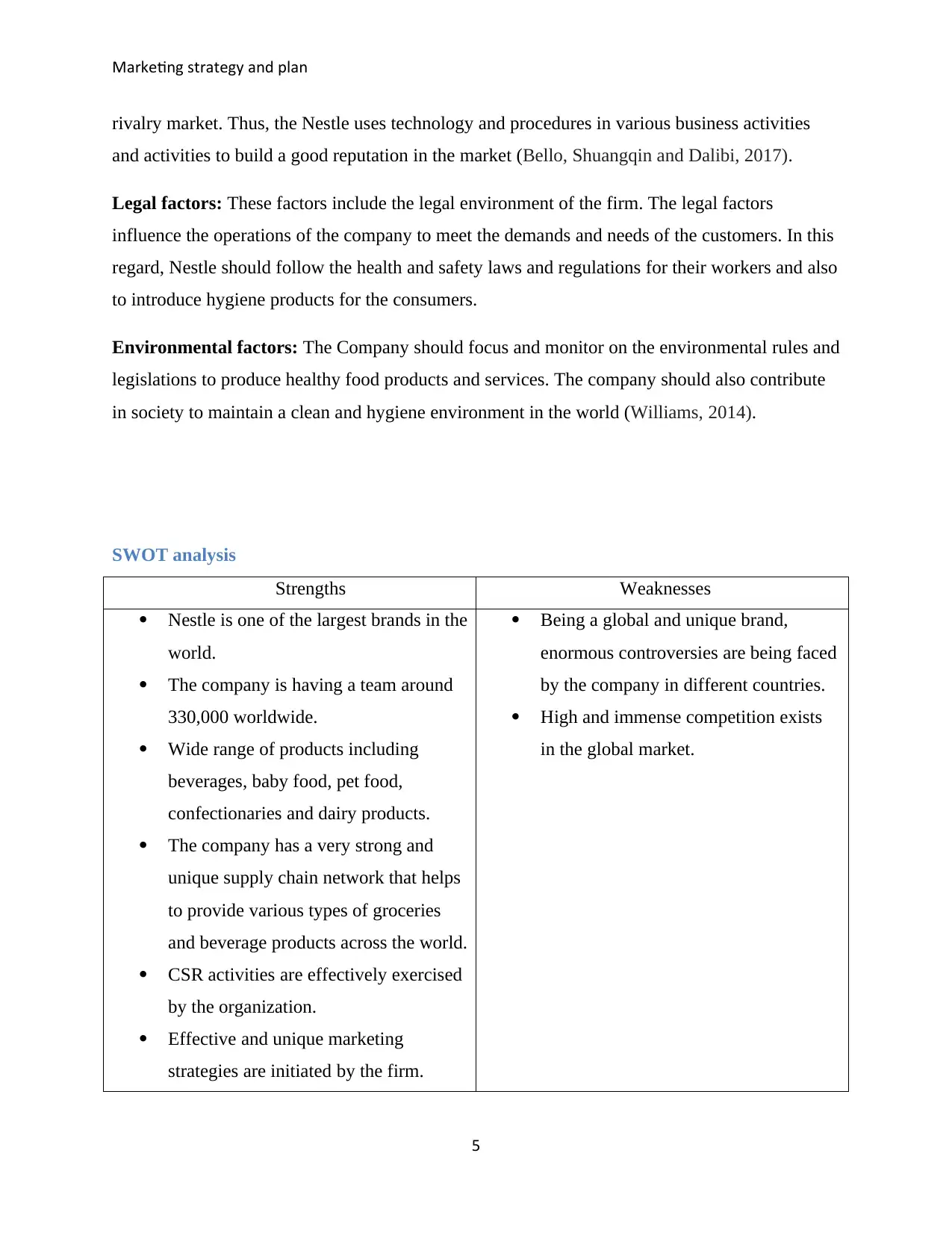
Marketing strategy and plan
rivalry market. Thus, the Nestle uses technology and procedures in various business activities
and activities to build a good reputation in the market (Bello, Shuangqin and Dalibi, 2017).
Legal factors: These factors include the legal environment of the firm. The legal factors
influence the operations of the company to meet the demands and needs of the customers. In this
regard, Nestle should follow the health and safety laws and regulations for their workers and also
to introduce hygiene products for the consumers.
Environmental factors: The Company should focus and monitor on the environmental rules and
legislations to produce healthy food products and services. The company should also contribute
in society to maintain a clean and hygiene environment in the world (Williams, 2014).
SWOT analysis
Strengths Weaknesses
Nestle is one of the largest brands in the
world.
The company is having a team around
330,000 worldwide.
Wide range of products including
beverages, baby food, pet food,
confectionaries and dairy products.
The company has a very strong and
unique supply chain network that helps
to provide various types of groceries
and beverage products across the world.
CSR activities are effectively exercised
by the organization.
Effective and unique marketing
strategies are initiated by the firm.
Being a global and unique brand,
enormous controversies are being faced
by the company in different countries.
High and immense competition exists
in the global market.
5
rivalry market. Thus, the Nestle uses technology and procedures in various business activities
and activities to build a good reputation in the market (Bello, Shuangqin and Dalibi, 2017).
Legal factors: These factors include the legal environment of the firm. The legal factors
influence the operations of the company to meet the demands and needs of the customers. In this
regard, Nestle should follow the health and safety laws and regulations for their workers and also
to introduce hygiene products for the consumers.
Environmental factors: The Company should focus and monitor on the environmental rules and
legislations to produce healthy food products and services. The company should also contribute
in society to maintain a clean and hygiene environment in the world (Williams, 2014).
SWOT analysis
Strengths Weaknesses
Nestle is one of the largest brands in the
world.
The company is having a team around
330,000 worldwide.
Wide range of products including
beverages, baby food, pet food,
confectionaries and dairy products.
The company has a very strong and
unique supply chain network that helps
to provide various types of groceries
and beverage products across the world.
CSR activities are effectively exercised
by the organization.
Effective and unique marketing
strategies are initiated by the firm.
Being a global and unique brand,
enormous controversies are being faced
by the company in different countries.
High and immense competition exists
in the global market.
5
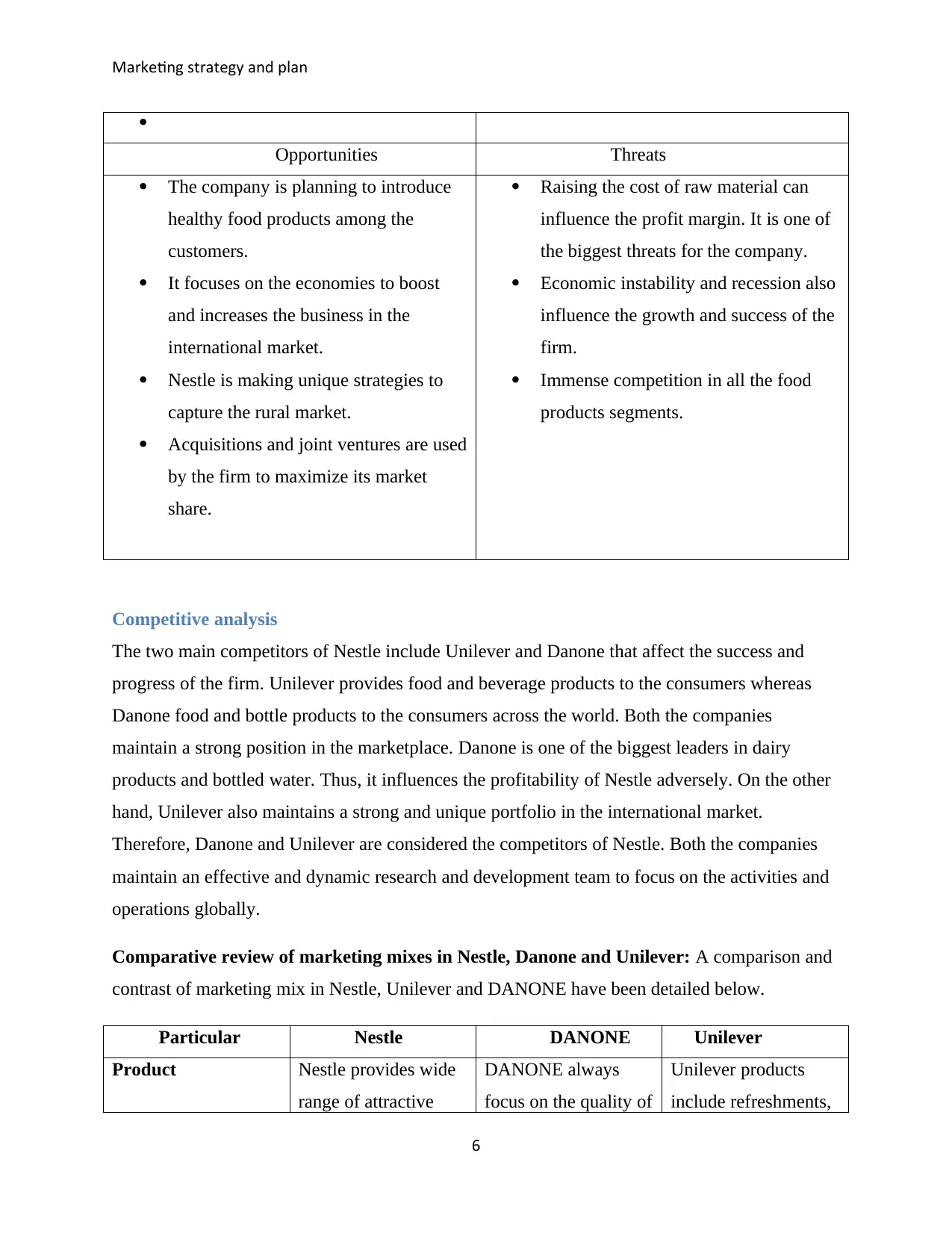
Marketing strategy and plan
Opportunities Threats
The company is planning to introduce
healthy food products among the
customers.
It focuses on the economies to boost
and increases the business in the
international market.
Nestle is making unique strategies to
capture the rural market.
Acquisitions and joint ventures are used
by the firm to maximize its market
share.
Raising the cost of raw material can
influence the profit margin. It is one of
the biggest threats for the company.
Economic instability and recession also
influence the growth and success of the
firm.
Immense competition in all the food
products segments.
Competitive analysis
The two main competitors of Nestle include Unilever and Danone that affect the success and
progress of the firm. Unilever provides food and beverage products to the consumers whereas
Danone food and bottle products to the consumers across the world. Both the companies
maintain a strong position in the marketplace. Danone is one of the biggest leaders in dairy
products and bottled water. Thus, it influences the profitability of Nestle adversely. On the other
hand, Unilever also maintains a strong and unique portfolio in the international market.
Therefore, Danone and Unilever are considered the competitors of Nestle. Both the companies
maintain an effective and dynamic research and development team to focus on the activities and
operations globally.
Comparative review of marketing mixes in Nestle, Danone and Unilever: A comparison and
contrast of marketing mix in Nestle, Unilever and DANONE have been detailed below.
Particular Nestle DANONE Unilever
Product Nestle provides wide
range of attractive
DANONE always
focus on the quality of
Unilever products
include refreshments,
6
Opportunities Threats
The company is planning to introduce
healthy food products among the
customers.
It focuses on the economies to boost
and increases the business in the
international market.
Nestle is making unique strategies to
capture the rural market.
Acquisitions and joint ventures are used
by the firm to maximize its market
share.
Raising the cost of raw material can
influence the profit margin. It is one of
the biggest threats for the company.
Economic instability and recession also
influence the growth and success of the
firm.
Immense competition in all the food
products segments.
Competitive analysis
The two main competitors of Nestle include Unilever and Danone that affect the success and
progress of the firm. Unilever provides food and beverage products to the consumers whereas
Danone food and bottle products to the consumers across the world. Both the companies
maintain a strong position in the marketplace. Danone is one of the biggest leaders in dairy
products and bottled water. Thus, it influences the profitability of Nestle adversely. On the other
hand, Unilever also maintains a strong and unique portfolio in the international market.
Therefore, Danone and Unilever are considered the competitors of Nestle. Both the companies
maintain an effective and dynamic research and development team to focus on the activities and
operations globally.
Comparative review of marketing mixes in Nestle, Danone and Unilever: A comparison and
contrast of marketing mix in Nestle, Unilever and DANONE have been detailed below.
Particular Nestle DANONE Unilever
Product Nestle provides wide
range of attractive
DANONE always
focus on the quality of
Unilever products
include refreshments,
6
⊘ This is a preview!⊘
Do you want full access?
Subscribe today to unlock all pages.

Trusted by 1+ million students worldwide
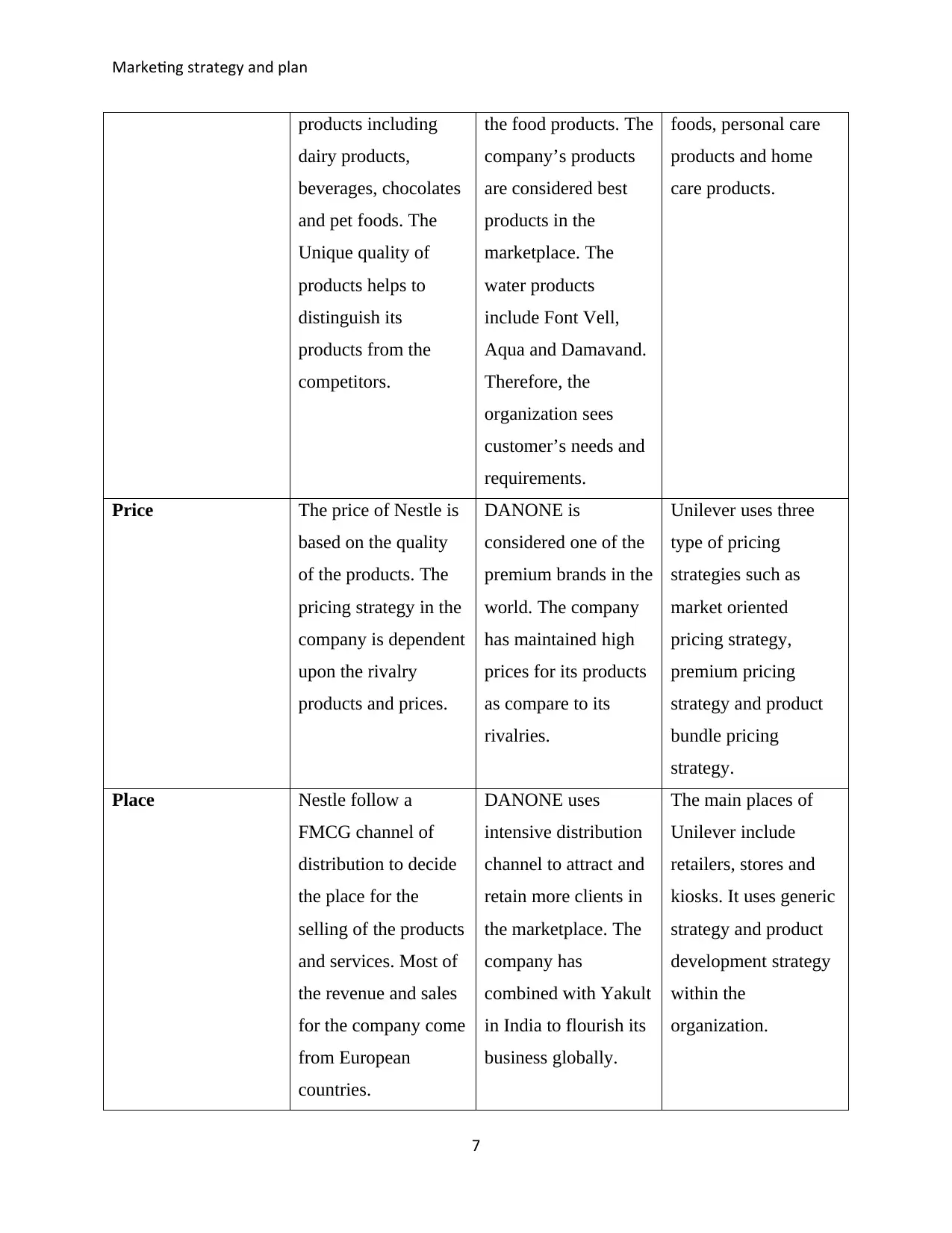
Marketing strategy and plan
products including
dairy products,
beverages, chocolates
and pet foods. The
Unique quality of
products helps to
distinguish its
products from the
competitors.
the food products. The
company’s products
are considered best
products in the
marketplace. The
water products
include Font Vell,
Aqua and Damavand.
Therefore, the
organization sees
customer’s needs and
requirements.
foods, personal care
products and home
care products.
Price The price of Nestle is
based on the quality
of the products. The
pricing strategy in the
company is dependent
upon the rivalry
products and prices.
DANONE is
considered one of the
premium brands in the
world. The company
has maintained high
prices for its products
as compare to its
rivalries.
Unilever uses three
type of pricing
strategies such as
market oriented
pricing strategy,
premium pricing
strategy and product
bundle pricing
strategy.
Place Nestle follow a
FMCG channel of
distribution to decide
the place for the
selling of the products
and services. Most of
the revenue and sales
for the company come
from European
countries.
DANONE uses
intensive distribution
channel to attract and
retain more clients in
the marketplace. The
company has
combined with Yakult
in India to flourish its
business globally.
The main places of
Unilever include
retailers, stores and
kiosks. It uses generic
strategy and product
development strategy
within the
organization.
7
products including
dairy products,
beverages, chocolates
and pet foods. The
Unique quality of
products helps to
distinguish its
products from the
competitors.
the food products. The
company’s products
are considered best
products in the
marketplace. The
water products
include Font Vell,
Aqua and Damavand.
Therefore, the
organization sees
customer’s needs and
requirements.
foods, personal care
products and home
care products.
Price The price of Nestle is
based on the quality
of the products. The
pricing strategy in the
company is dependent
upon the rivalry
products and prices.
DANONE is
considered one of the
premium brands in the
world. The company
has maintained high
prices for its products
as compare to its
rivalries.
Unilever uses three
type of pricing
strategies such as
market oriented
pricing strategy,
premium pricing
strategy and product
bundle pricing
strategy.
Place Nestle follow a
FMCG channel of
distribution to decide
the place for the
selling of the products
and services. Most of
the revenue and sales
for the company come
from European
countries.
DANONE uses
intensive distribution
channel to attract and
retain more clients in
the marketplace. The
company has
combined with Yakult
in India to flourish its
business globally.
The main places of
Unilever include
retailers, stores and
kiosks. It uses generic
strategy and product
development strategy
within the
organization.
7
Paraphrase This Document
Need a fresh take? Get an instant paraphrase of this document with our AI Paraphraser
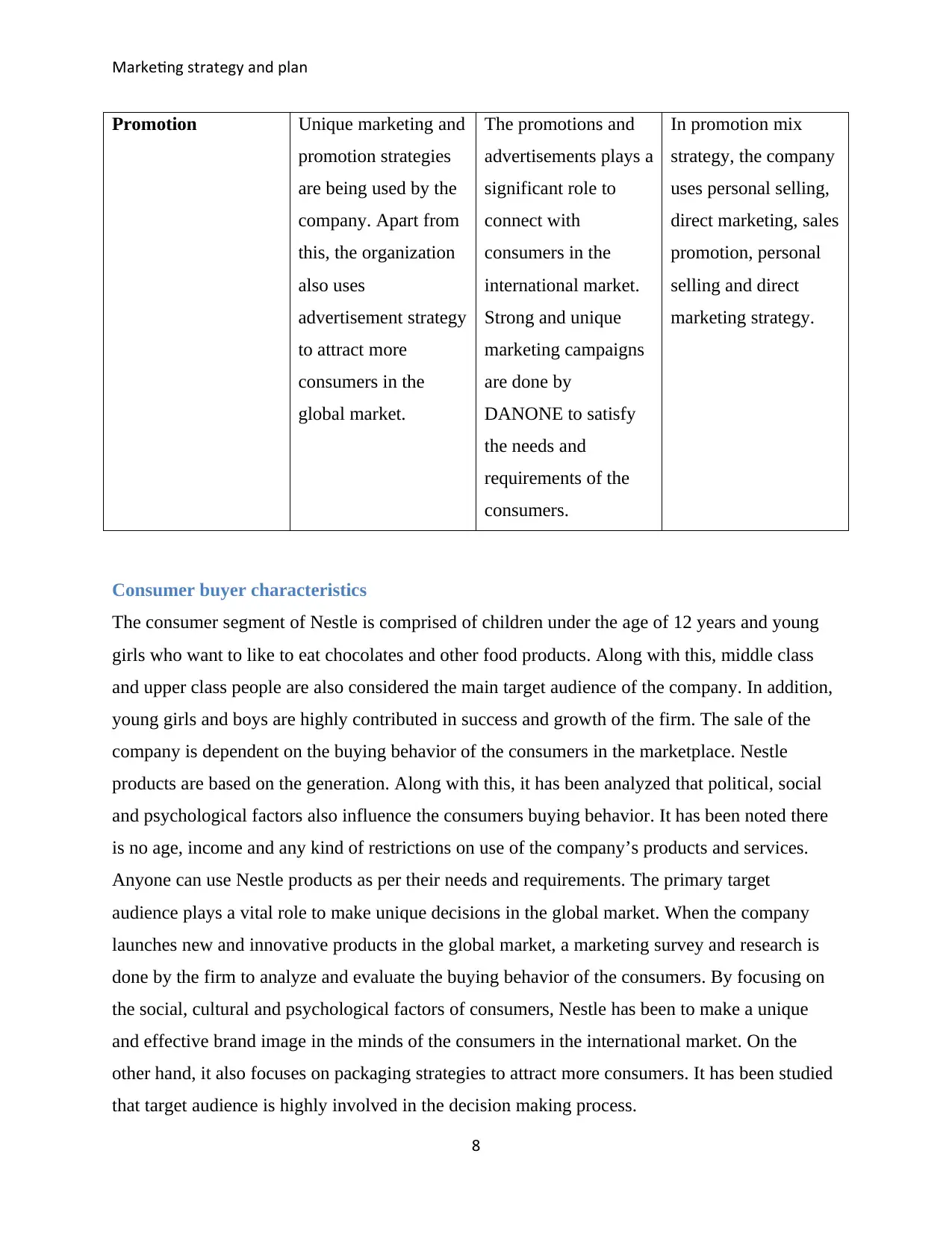
Marketing strategy and plan
Promotion Unique marketing and
promotion strategies
are being used by the
company. Apart from
this, the organization
also uses
advertisement strategy
to attract more
consumers in the
global market.
The promotions and
advertisements plays a
significant role to
connect with
consumers in the
international market.
Strong and unique
marketing campaigns
are done by
DANONE to satisfy
the needs and
requirements of the
consumers.
In promotion mix
strategy, the company
uses personal selling,
direct marketing, sales
promotion, personal
selling and direct
marketing strategy.
Consumer buyer characteristics
The consumer segment of Nestle is comprised of children under the age of 12 years and young
girls who want to like to eat chocolates and other food products. Along with this, middle class
and upper class people are also considered the main target audience of the company. In addition,
young girls and boys are highly contributed in success and growth of the firm. The sale of the
company is dependent on the buying behavior of the consumers in the marketplace. Nestle
products are based on the generation. Along with this, it has been analyzed that political, social
and psychological factors also influence the consumers buying behavior. It has been noted there
is no age, income and any kind of restrictions on use of the company’s products and services.
Anyone can use Nestle products as per their needs and requirements. The primary target
audience plays a vital role to make unique decisions in the global market. When the company
launches new and innovative products in the global market, a marketing survey and research is
done by the firm to analyze and evaluate the buying behavior of the consumers. By focusing on
the social, cultural and psychological factors of consumers, Nestle has been to make a unique
and effective brand image in the minds of the consumers in the international market. On the
other hand, it also focuses on packaging strategies to attract more consumers. It has been studied
that target audience is highly involved in the decision making process.
8
Promotion Unique marketing and
promotion strategies
are being used by the
company. Apart from
this, the organization
also uses
advertisement strategy
to attract more
consumers in the
global market.
The promotions and
advertisements plays a
significant role to
connect with
consumers in the
international market.
Strong and unique
marketing campaigns
are done by
DANONE to satisfy
the needs and
requirements of the
consumers.
In promotion mix
strategy, the company
uses personal selling,
direct marketing, sales
promotion, personal
selling and direct
marketing strategy.
Consumer buyer characteristics
The consumer segment of Nestle is comprised of children under the age of 12 years and young
girls who want to like to eat chocolates and other food products. Along with this, middle class
and upper class people are also considered the main target audience of the company. In addition,
young girls and boys are highly contributed in success and growth of the firm. The sale of the
company is dependent on the buying behavior of the consumers in the marketplace. Nestle
products are based on the generation. Along with this, it has been analyzed that political, social
and psychological factors also influence the consumers buying behavior. It has been noted there
is no age, income and any kind of restrictions on use of the company’s products and services.
Anyone can use Nestle products as per their needs and requirements. The primary target
audience plays a vital role to make unique decisions in the global market. When the company
launches new and innovative products in the global market, a marketing survey and research is
done by the firm to analyze and evaluate the buying behavior of the consumers. By focusing on
the social, cultural and psychological factors of consumers, Nestle has been to make a unique
and effective brand image in the minds of the consumers in the international market. On the
other hand, it also focuses on packaging strategies to attract more consumers. It has been studied
that target audience is highly involved in the decision making process.
8
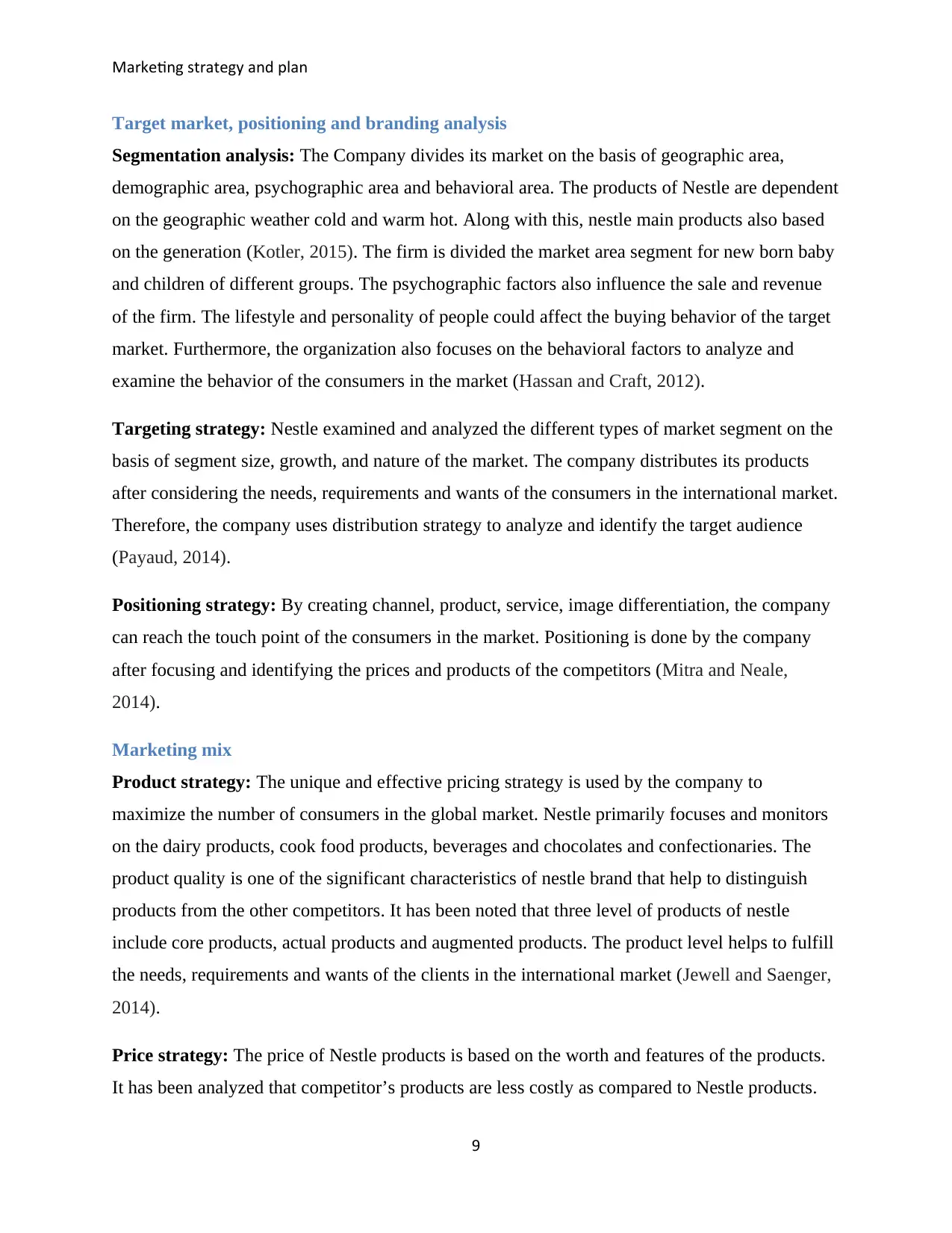
Marketing strategy and plan
Target market, positioning and branding analysis
Segmentation analysis: The Company divides its market on the basis of geographic area,
demographic area, psychographic area and behavioral area. The products of Nestle are dependent
on the geographic weather cold and warm hot. Along with this, nestle main products also based
on the generation (Kotler, 2015). The firm is divided the market area segment for new born baby
and children of different groups. The psychographic factors also influence the sale and revenue
of the firm. The lifestyle and personality of people could affect the buying behavior of the target
market. Furthermore, the organization also focuses on the behavioral factors to analyze and
examine the behavior of the consumers in the market (Hassan and Craft, 2012).
Targeting strategy: Nestle examined and analyzed the different types of market segment on the
basis of segment size, growth, and nature of the market. The company distributes its products
after considering the needs, requirements and wants of the consumers in the international market.
Therefore, the company uses distribution strategy to analyze and identify the target audience
(Payaud, 2014).
Positioning strategy: By creating channel, product, service, image differentiation, the company
can reach the touch point of the consumers in the market. Positioning is done by the company
after focusing and identifying the prices and products of the competitors (Mitra and Neale,
2014).
Marketing mix
Product strategy: The unique and effective pricing strategy is used by the company to
maximize the number of consumers in the global market. Nestle primarily focuses and monitors
on the dairy products, cook food products, beverages and chocolates and confectionaries. The
product quality is one of the significant characteristics of nestle brand that help to distinguish
products from the other competitors. It has been noted that three level of products of nestle
include core products, actual products and augmented products. The product level helps to fulfill
the needs, requirements and wants of the clients in the international market (Jewell and Saenger,
2014).
Price strategy: The price of Nestle products is based on the worth and features of the products.
It has been analyzed that competitor’s products are less costly as compared to Nestle products.
9
Target market, positioning and branding analysis
Segmentation analysis: The Company divides its market on the basis of geographic area,
demographic area, psychographic area and behavioral area. The products of Nestle are dependent
on the geographic weather cold and warm hot. Along with this, nestle main products also based
on the generation (Kotler, 2015). The firm is divided the market area segment for new born baby
and children of different groups. The psychographic factors also influence the sale and revenue
of the firm. The lifestyle and personality of people could affect the buying behavior of the target
market. Furthermore, the organization also focuses on the behavioral factors to analyze and
examine the behavior of the consumers in the market (Hassan and Craft, 2012).
Targeting strategy: Nestle examined and analyzed the different types of market segment on the
basis of segment size, growth, and nature of the market. The company distributes its products
after considering the needs, requirements and wants of the consumers in the international market.
Therefore, the company uses distribution strategy to analyze and identify the target audience
(Payaud, 2014).
Positioning strategy: By creating channel, product, service, image differentiation, the company
can reach the touch point of the consumers in the market. Positioning is done by the company
after focusing and identifying the prices and products of the competitors (Mitra and Neale,
2014).
Marketing mix
Product strategy: The unique and effective pricing strategy is used by the company to
maximize the number of consumers in the global market. Nestle primarily focuses and monitors
on the dairy products, cook food products, beverages and chocolates and confectionaries. The
product quality is one of the significant characteristics of nestle brand that help to distinguish
products from the other competitors. It has been noted that three level of products of nestle
include core products, actual products and augmented products. The product level helps to fulfill
the needs, requirements and wants of the clients in the international market (Jewell and Saenger,
2014).
Price strategy: The price of Nestle products is based on the worth and features of the products.
It has been analyzed that competitor’s products are less costly as compared to Nestle products.
9
⊘ This is a preview!⊘
Do you want full access?
Subscribe today to unlock all pages.

Trusted by 1+ million students worldwide
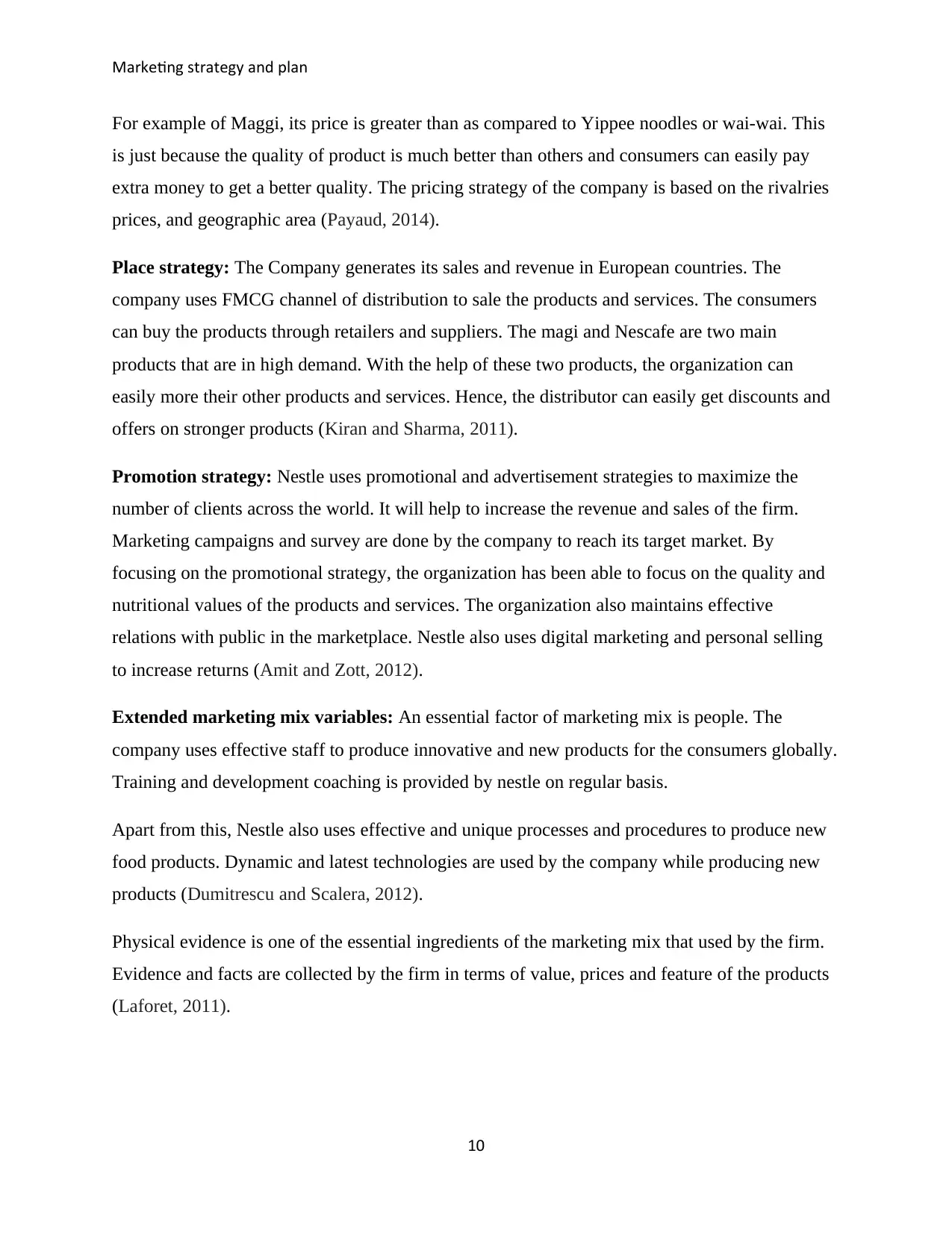
Marketing strategy and plan
For example of Maggi, its price is greater than as compared to Yippee noodles or wai-wai. This
is just because the quality of product is much better than others and consumers can easily pay
extra money to get a better quality. The pricing strategy of the company is based on the rivalries
prices, and geographic area (Payaud, 2014).
Place strategy: The Company generates its sales and revenue in European countries. The
company uses FMCG channel of distribution to sale the products and services. The consumers
can buy the products through retailers and suppliers. The magi and Nescafe are two main
products that are in high demand. With the help of these two products, the organization can
easily more their other products and services. Hence, the distributor can easily get discounts and
offers on stronger products (Kiran and Sharma, 2011).
Promotion strategy: Nestle uses promotional and advertisement strategies to maximize the
number of clients across the world. It will help to increase the revenue and sales of the firm.
Marketing campaigns and survey are done by the company to reach its target market. By
focusing on the promotional strategy, the organization has been able to focus on the quality and
nutritional values of the products and services. The organization also maintains effective
relations with public in the marketplace. Nestle also uses digital marketing and personal selling
to increase returns (Amit and Zott, 2012).
Extended marketing mix variables: An essential factor of marketing mix is people. The
company uses effective staff to produce innovative and new products for the consumers globally.
Training and development coaching is provided by nestle on regular basis.
Apart from this, Nestle also uses effective and unique processes and procedures to produce new
food products. Dynamic and latest technologies are used by the company while producing new
products (Dumitrescu and Scalera, 2012).
Physical evidence is one of the essential ingredients of the marketing mix that used by the firm.
Evidence and facts are collected by the firm in terms of value, prices and feature of the products
(Laforet, 2011).
10
For example of Maggi, its price is greater than as compared to Yippee noodles or wai-wai. This
is just because the quality of product is much better than others and consumers can easily pay
extra money to get a better quality. The pricing strategy of the company is based on the rivalries
prices, and geographic area (Payaud, 2014).
Place strategy: The Company generates its sales and revenue in European countries. The
company uses FMCG channel of distribution to sale the products and services. The consumers
can buy the products through retailers and suppliers. The magi and Nescafe are two main
products that are in high demand. With the help of these two products, the organization can
easily more their other products and services. Hence, the distributor can easily get discounts and
offers on stronger products (Kiran and Sharma, 2011).
Promotion strategy: Nestle uses promotional and advertisement strategies to maximize the
number of clients across the world. It will help to increase the revenue and sales of the firm.
Marketing campaigns and survey are done by the company to reach its target market. By
focusing on the promotional strategy, the organization has been able to focus on the quality and
nutritional values of the products and services. The organization also maintains effective
relations with public in the marketplace. Nestle also uses digital marketing and personal selling
to increase returns (Amit and Zott, 2012).
Extended marketing mix variables: An essential factor of marketing mix is people. The
company uses effective staff to produce innovative and new products for the consumers globally.
Training and development coaching is provided by nestle on regular basis.
Apart from this, Nestle also uses effective and unique processes and procedures to produce new
food products. Dynamic and latest technologies are used by the company while producing new
products (Dumitrescu and Scalera, 2012).
Physical evidence is one of the essential ingredients of the marketing mix that used by the firm.
Evidence and facts are collected by the firm in terms of value, prices and feature of the products
(Laforet, 2011).
10
Paraphrase This Document
Need a fresh take? Get an instant paraphrase of this document with our AI Paraphraser
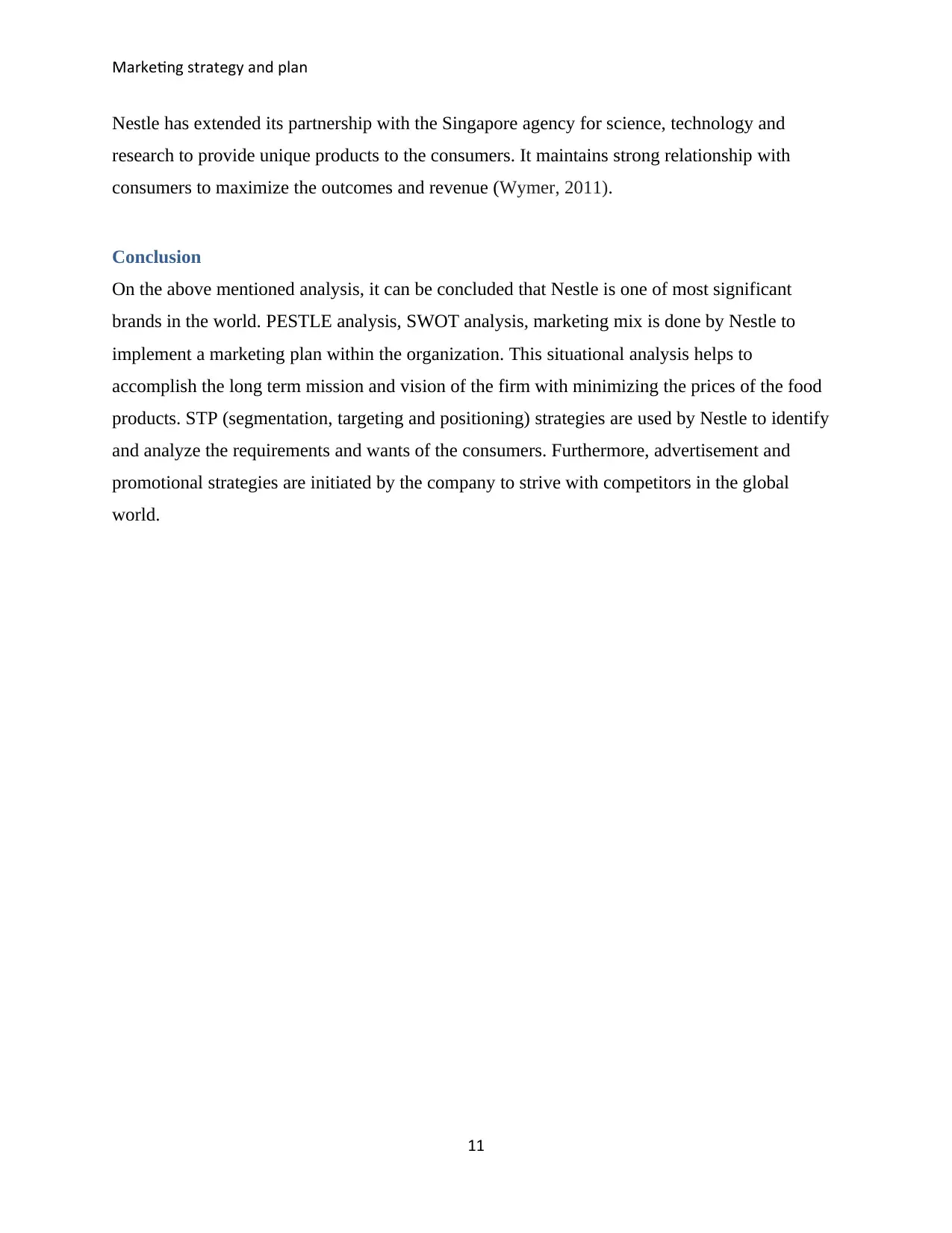
Marketing strategy and plan
Nestle has extended its partnership with the Singapore agency for science, technology and
research to provide unique products to the consumers. It maintains strong relationship with
consumers to maximize the outcomes and revenue (Wymer, 2011).
Conclusion
On the above mentioned analysis, it can be concluded that Nestle is one of most significant
brands in the world. PESTLE analysis, SWOT analysis, marketing mix is done by Nestle to
implement a marketing plan within the organization. This situational analysis helps to
accomplish the long term mission and vision of the firm with minimizing the prices of the food
products. STP (segmentation, targeting and positioning) strategies are used by Nestle to identify
and analyze the requirements and wants of the consumers. Furthermore, advertisement and
promotional strategies are initiated by the company to strive with competitors in the global
world.
11
Nestle has extended its partnership with the Singapore agency for science, technology and
research to provide unique products to the consumers. It maintains strong relationship with
consumers to maximize the outcomes and revenue (Wymer, 2011).
Conclusion
On the above mentioned analysis, it can be concluded that Nestle is one of most significant
brands in the world. PESTLE analysis, SWOT analysis, marketing mix is done by Nestle to
implement a marketing plan within the organization. This situational analysis helps to
accomplish the long term mission and vision of the firm with minimizing the prices of the food
products. STP (segmentation, targeting and positioning) strategies are used by Nestle to identify
and analyze the requirements and wants of the consumers. Furthermore, advertisement and
promotional strategies are initiated by the company to strive with competitors in the global
world.
11
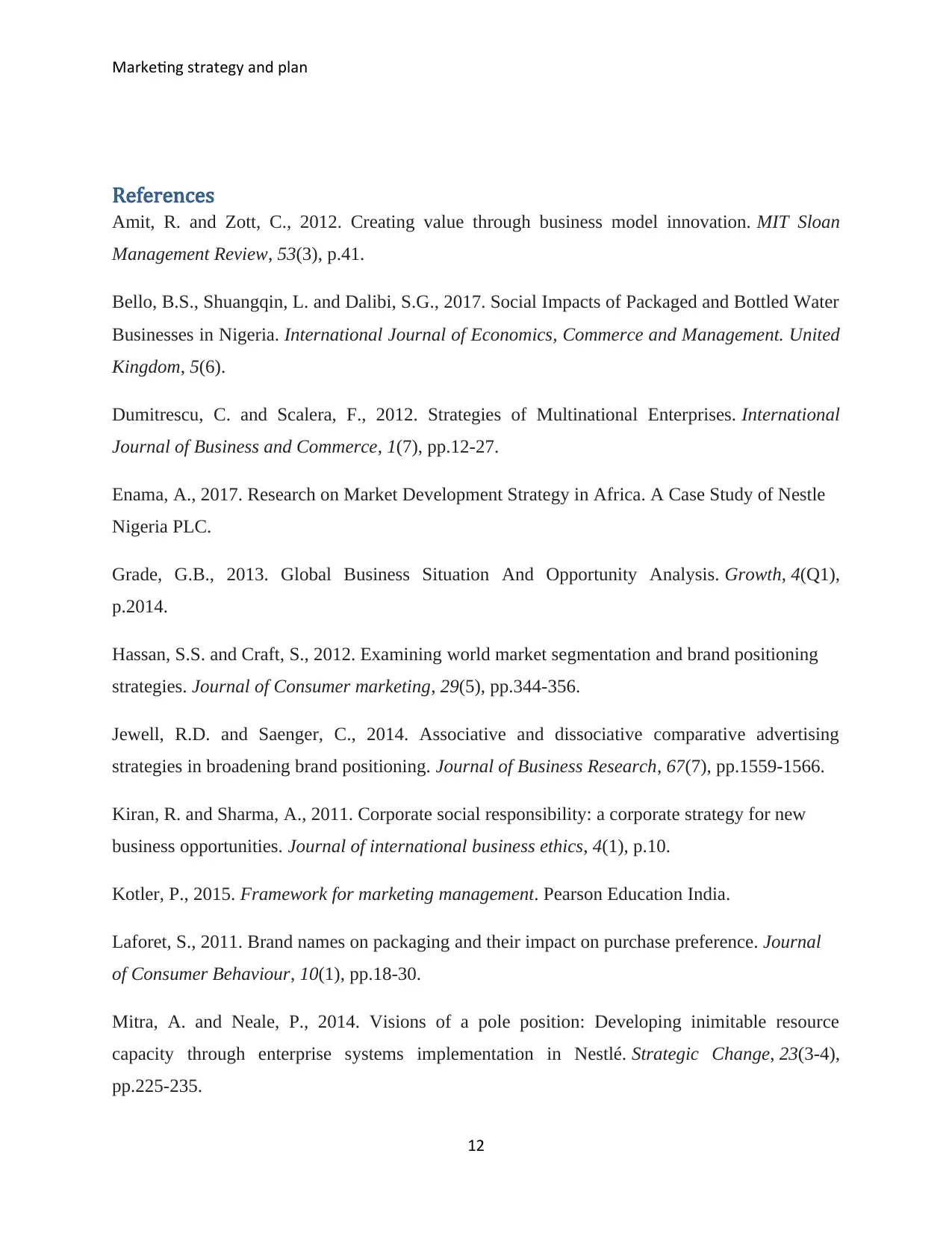
Marketing strategy and plan
References
Amit, R. and Zott, C., 2012. Creating value through business model innovation. MIT Sloan
Management Review, 53(3), p.41.
Bello, B.S., Shuangqin, L. and Dalibi, S.G., 2017. Social Impacts of Packaged and Bottled Water
Businesses in Nigeria. International Journal of Economics, Commerce and Management. United
Kingdom, 5(6).
Dumitrescu, C. and Scalera, F., 2012. Strategies of Multinational Enterprises. International
Journal of Business and Commerce, 1(7), pp.12-27.
Enama, A., 2017. Research on Market Development Strategy in Africa. A Case Study of Nestle
Nigeria PLC.
Grade, G.B., 2013. Global Business Situation And Opportunity Analysis. Growth, 4(Q1),
p.2014.
Hassan, S.S. and Craft, S., 2012. Examining world market segmentation and brand positioning
strategies. Journal of Consumer marketing, 29(5), pp.344-356.
Jewell, R.D. and Saenger, C., 2014. Associative and dissociative comparative advertising
strategies in broadening brand positioning. Journal of Business Research, 67(7), pp.1559-1566.
Kiran, R. and Sharma, A., 2011. Corporate social responsibility: a corporate strategy for new
business opportunities. Journal of international business ethics, 4(1), p.10.
Kotler, P., 2015. Framework for marketing management. Pearson Education India.
Laforet, S., 2011. Brand names on packaging and their impact on purchase preference. Journal
of Consumer Behaviour, 10(1), pp.18-30.
Mitra, A. and Neale, P., 2014. Visions of a pole position: Developing inimitable resource
capacity through enterprise systems implementation in Nestlé. Strategic Change, 23(3-4),
pp.225-235.
12
References
Amit, R. and Zott, C., 2012. Creating value through business model innovation. MIT Sloan
Management Review, 53(3), p.41.
Bello, B.S., Shuangqin, L. and Dalibi, S.G., 2017. Social Impacts of Packaged and Bottled Water
Businesses in Nigeria. International Journal of Economics, Commerce and Management. United
Kingdom, 5(6).
Dumitrescu, C. and Scalera, F., 2012. Strategies of Multinational Enterprises. International
Journal of Business and Commerce, 1(7), pp.12-27.
Enama, A., 2017. Research on Market Development Strategy in Africa. A Case Study of Nestle
Nigeria PLC.
Grade, G.B., 2013. Global Business Situation And Opportunity Analysis. Growth, 4(Q1),
p.2014.
Hassan, S.S. and Craft, S., 2012. Examining world market segmentation and brand positioning
strategies. Journal of Consumer marketing, 29(5), pp.344-356.
Jewell, R.D. and Saenger, C., 2014. Associative and dissociative comparative advertising
strategies in broadening brand positioning. Journal of Business Research, 67(7), pp.1559-1566.
Kiran, R. and Sharma, A., 2011. Corporate social responsibility: a corporate strategy for new
business opportunities. Journal of international business ethics, 4(1), p.10.
Kotler, P., 2015. Framework for marketing management. Pearson Education India.
Laforet, S., 2011. Brand names on packaging and their impact on purchase preference. Journal
of Consumer Behaviour, 10(1), pp.18-30.
Mitra, A. and Neale, P., 2014. Visions of a pole position: Developing inimitable resource
capacity through enterprise systems implementation in Nestlé. Strategic Change, 23(3-4),
pp.225-235.
12
⊘ This is a preview!⊘
Do you want full access?
Subscribe today to unlock all pages.

Trusted by 1+ million students worldwide
1 out of 13
Related Documents
Your All-in-One AI-Powered Toolkit for Academic Success.
+13062052269
info@desklib.com
Available 24*7 on WhatsApp / Email
![[object Object]](/_next/static/media/star-bottom.7253800d.svg)
Unlock your academic potential
Copyright © 2020–2025 A2Z Services. All Rights Reserved. Developed and managed by ZUCOL.





